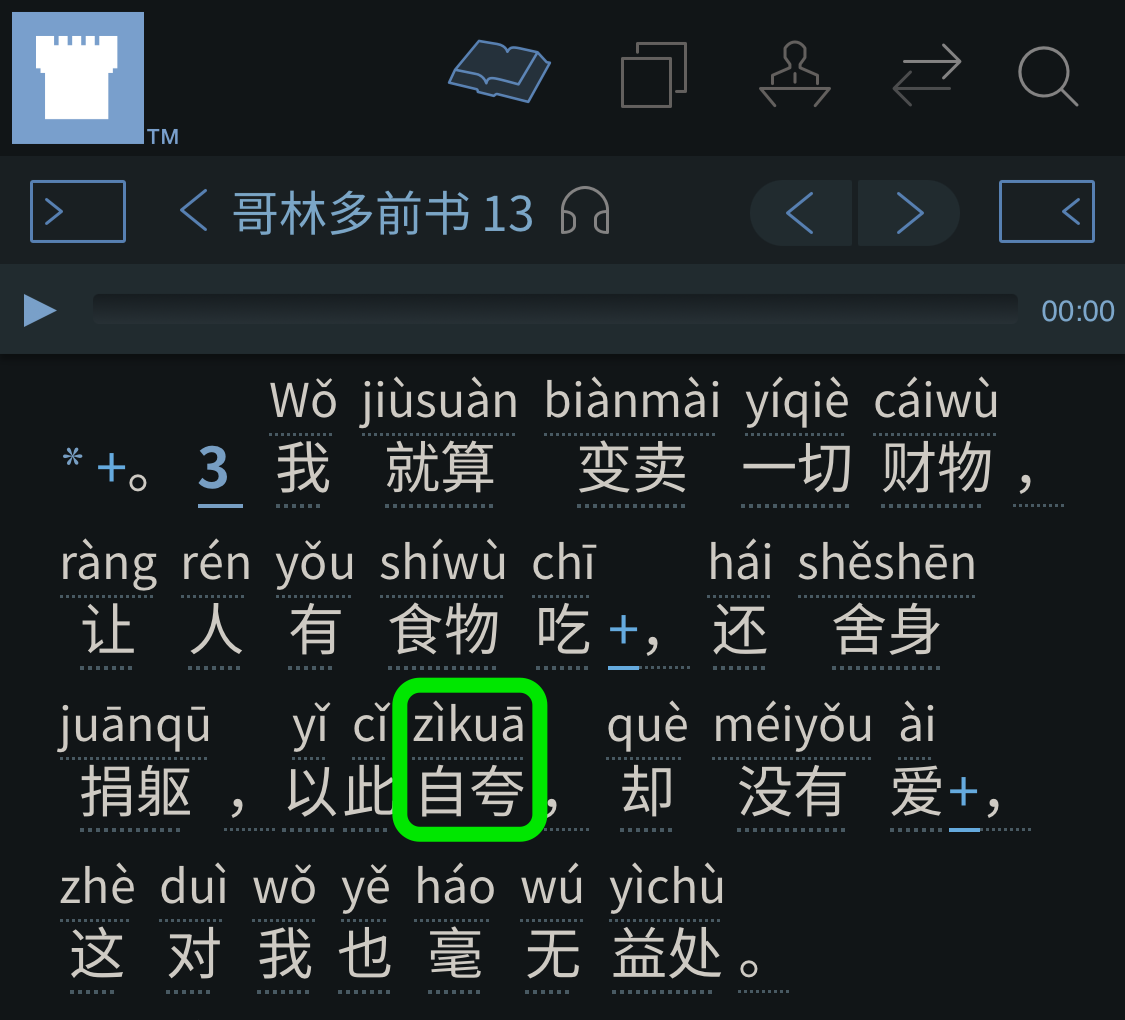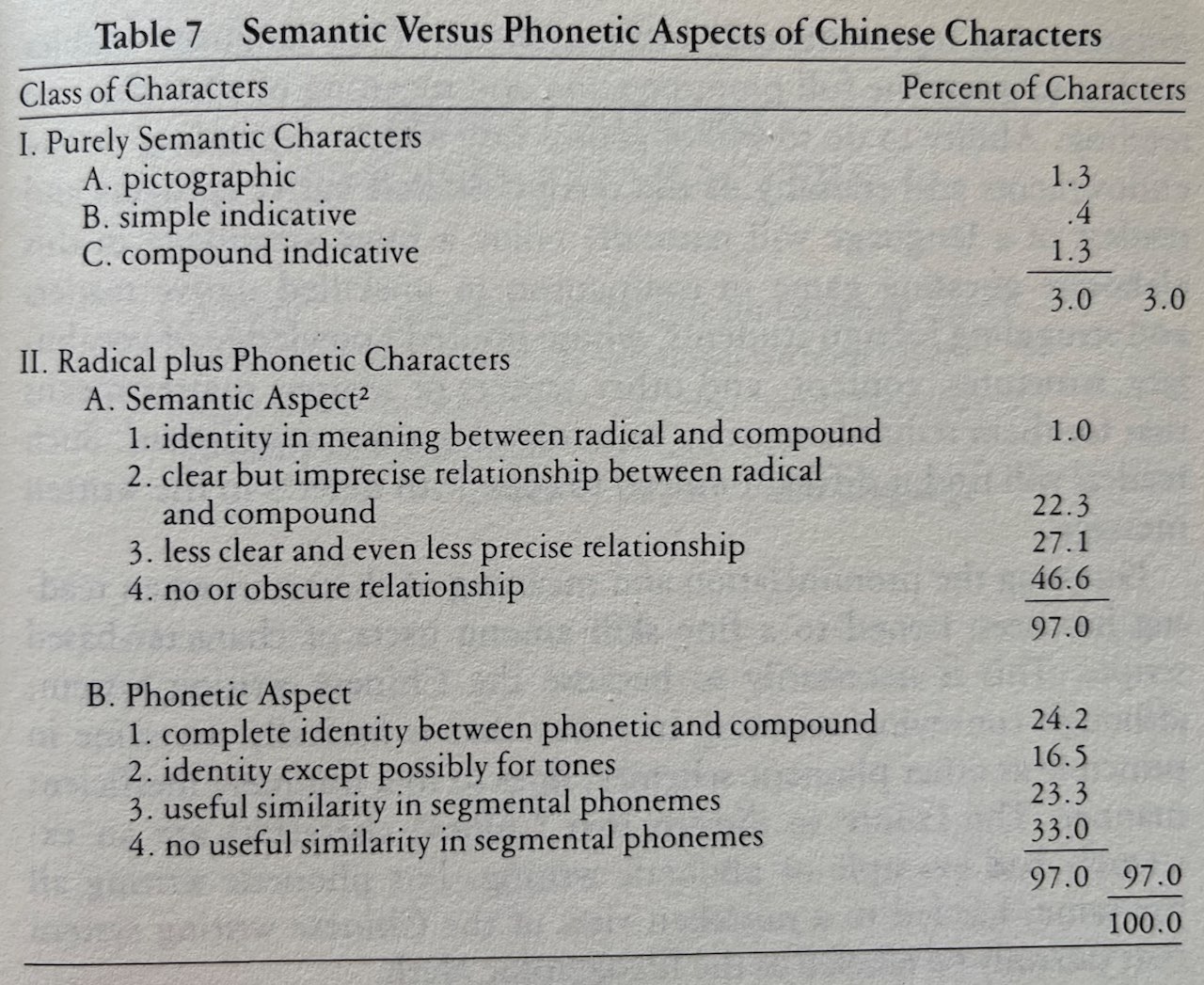zìkuā (zì·kuā {[(about)] self} · {exaggerate; overstate; boast; brag | praise; compliment} 自夸 自誇) ← Tap/click to show/hide the “flashcard”
[Notes: Tap/click on a Pīnyīn (Pīn·yīn {Piecing Together of} · Sounds → [Pinyin] 拼音) expression to reveal its “flashcard”; tap/click on a “flashcard” or its Pīnyīn (Pīn·yīn {Piecing Together of} · Sounds → [Pinyin] 拼音) expression to hide the “flashcard”. 📖 📄 📘 icons mean 📖 Reveal All, 📄 Reveal Advanced, and 📘 Reveal None re all the “flashcards” in the heading, paragraph, etc. that they are placed at the beginning of.]
I have long especially liked 1 Corinthians 13. It contains counsel on what really does and doesn’t matter in life, an extensive description and definition of the most important kind of love, and a sublime discussion about the need to become complete, mature, as a person. As these apply to life in general, so too do they apply to our lives as Mandarin field language learners.
As Mandarin field language learners, it can benefit us greatly to consider what we can learn from 1 Corinthians 13, and along the way, we can also consider some of the Mandarin expressions used in that chapter in the current version of the Mandarin New World Translation Bible (nwtsty).
“…So That I May Boast”
This week’s MEotW, “zìkuā (zì·kuā {[(about)] self} · {exaggerate; overstate; boast; brag | praise; compliment} 自夸 自誇)”, is used in verse 3 (WOL, Pīnyīn (Pīn·yīn {Piecing Together of} · Sounds → [Pinyin] 拼音) Plus) of 1 Corinthians 13:

(Dark mode for the Watchtower ONLINE LIBRARY (WOL) website, as shown in the above image, can be enabled in the Safari web browser by using the Noir Safari extension.)
In “zìkuā (zì·kuā {[(about)] self} · {exaggerate; overstate; boast; brag | praise; compliment} 自夸 自誇)”, “zì (self | from; since 自)” can mean “(about) self”. (In other expressions, such as “zìjǐ (self[’s] 自己)” or “zìyóu (zì·yóu self-·determining → [free | freedom] 自由)”, it just means “self”.) As for “kuā ({exaggerate; overstate; boast; brag | praise; compliment} 夸 誇/夸)”, it means “exaggerate; overstate; boast; brag” or “praise; compliment”. So, “zìkuā (zì·kuā {[(about)] self} · {exaggerate; overstate; boast; brag | praise; compliment} 自夸 自誇)” can effectively mean “boast/brag/etc. about oneself”.
Below are English and Pīnyīn (Pīn·yīn {Piecing Together of} · Sounds → [Pinyin] 拼音) Plus renditions showing how “zìkuā (zì·kuā {[(about)] self} · {exaggerate; overstate; boast; brag | praise; compliment} 自夸 自誇)” is used in 1 Corinthians 13:3 in the current version of the Mandarin NWT Bible to correspond to “boast”, which is used in that verse in the current version of the English NWT Bible:
And if I give all my belongings to feed others, and if I hand over my body so that I may boast, but do not have love, I do not benefit at all.
Mandarin (WOL, Pīnyīn (Pīn·yīn {Piecing Together of} · Sounds → [Pinyin] 拼音) Plus):
📖 📄 📘 Wǒ (I 我) jiùsuàn (jiù·suàn {even if} · {figuring → [considering]} 就算) biànmài (biàn·mài changing · sell → [sell off] 变卖 變賣) yíqiè (yí·qiè {one (whole)} · {corresponding (set of)} → [all] 一切) cáiwù (cái·wù wealth · things → [belongings] 财物 財物), ràng ({to allow} 让 讓) rén (people 人) yǒu ({to have} 有) shíwù (shí·wù eating · matter → [food] 食物) chī ({to eat} 吃 吃/喫), hái (also 还 還) shěshēn (shě·shēn {give up} · {(my) body} 舍身 捨身) juānqū (juān·qū {relinquish → [contribute]} · {(my) human body} 捐躯 捐軀), yǐcǐ (yǐ·cǐ using · this 以此) zìkuā (zì·kuā {(about) self} · {to boast} 自夸 自誇), què (but 却 卻) méiyǒu (méi·yǒu not · {do have} 没有 沒有) ài (love 爱 愛), zhè (this 这 這) duì (towards → [to] 对 對) wǒ (me 我) yě (even 也) háowú (háo·wú {(even) a fine hair (of)} · {does not have} → [does not have even a little] 毫无 毫無) yìchu (yì·chu beneficial · place → [benefit] 益处 益處).
“Your Boasting Is Not Good”
Jehovah designed us, including specific parts of our bodies, such that the primary way we use language to communicate is with speech. (1 Corinthians 14:8–11) In contrast, writing is a human-invented technology, useful in some ways, but secondary at best compared to the gift of speech that Jehovah gave us.
So, if you are boasting, whether out loud or to yourself in your heart, about your knowledge of Chinese characters, which are particularly deeply problematic products of a worldly human culture, while neglecting to praise and appreciate Jehovah’s gift of speech, is it not so that, as 1 Corinthians 5:6 says, “your boasting is not good”? This is especially so because, as 1 John 2:15–17 tells us, we should “not love either the world or the things in the world”.
That scripture also warns us about “the desire of the eyes”. Chinese characters certainly have visually intricate designs that dazzle the eyes of many. The thing is, though, that language is not primarily about what’s visible to the eye. Rather, speech, the actual primary aspect of human language, is something that’s invisible to the eye. If we were to prioritize or even glamourize fancy visible writing over invisible speech that is actually what really matters language-wise, that could be considered linguistic idolatry—literal idolatry similarly involves worshipping visible idols of false gods rather than properly only worshipping the invisible true God.
Sure, in some situations characters are still the only form in which certain spiritually relevant information is written, so in such situations we must use characters to access and use that information in Jehovah’s service. However, that doesn’t mean that we need to love the characters for their own sake, or boast about our knowledge of them. Indeed, it is entirely appropriate to be dismayed by how the unnecessarily extraordinarily complex Chinese characters can make accessing and using important spiritual information much harder than necessary! While it’s still true that Pīnyīn (Pīn·yīn {Piecing Together of} · Sounds → [Pinyin] 拼音) is not yet everywhere that characters are in the Mandarin field, we should ask ourselves why Jehovah’s organization—which we understand to be directed by Jehovah and Jesus—has over time been making Pīnyīn (Pīn·yīn {Piecing Together of} · Sounds → [Pinyin] 拼音) available in more and more places that used to be characters-only.
Similarly, for a long time, the only Bibles available in England were ones written in Latin. While it was not totally impossible for people who lived in England at that time to learn Latin so as to be able to read and understand the Bible for themselves, it was very difficult for most, and practically impossible for many. (Many today similarly find Chinese characters very difficult, or even practically impossible, to deal with, and so they never join a Chinese field, or they may feel forced to leave after a time even if they do join a Chinese field.) In that not-so-merry old England, a privileged few may have boasted about their knowledge of Latin, but Jehovah’s organization has expressed clearly how it views that dark time.
“It makes cross-disciplinary communication very easy, which is key to innovation.”
Technically, since alphabetical writing systems could be used to write any language that Chinese characters are used to write, characters actually make everything HARDER than necessary.
— Troubadour WW (@troubadourww) January 3, 2024
The great things accomplished by Chinese people have been accomplished IN SPITE OF the unnecessarily complex characters, not because of them.
Imagine, if the Chinese had switched to an alphabet long ago, they may have gotten to the moon first, invented computers first, etc.
— Troubadour WW (@troubadourww) January 3, 2024
Chinese cool cat: “Méiyǒu” (“There aren’t any”)
Mandarin is in some ways a relatively easy language to learn. What IS really hard to deal with is the traditionally-used but extraordinarily complex & numerous Chinese characters.
Thankfully, simple, elegant _Pīnyīn_ is available. https://t.co/3CfYl8289b
— Troubadour WW (@troubadourww) May 16, 2024
“Glory from One Another”
Something to consider about boasting about characters is: Whom is one doing such boasting trying to impress? Is it Jehovah God? Is Jehovah really impressed by deep worldly knowledge of the culture of the proudly named “Zhōngguó (Zhōng·guó Central · Nation → [China] 中国 中國)” (“Central Kingdom”) that he will soon destroy and replace with his own Kingdom? (Daniel 2:44) Really, one who boasts about his knowledge of characters is generally boasting before other humans, is that not so? That being the case, such a one should take care to avoid becoming like the ones to whom Jesus directed the words at John 5:41–44:
I do not accept glory from men, but I well know that you do not have the love of God in you. I have come in the name of my Father, but you do not receive me. If someone else came in his own name, you would receive that one. How can you believe, when you are accepting glory from one another and you are not seeking the glory that is from the only God?
Jesus’ words above join the words at 1 Corinthians 13:3 to tell us that if certain ones do things so that they may boast, so that they may receive “glory from men”, “glory from one another”, such ones “do not have the love of God” in them, and so, they “do not benefit at all”.
“Boast in Jehovah”
Especially as ones who are dedicated to Jehovah God, we should focus on what brings glory to him, and on what brings us “the glory that is from the only God”. We should not seek the fading glories of some worldly human culture, even if that culture is as old and storied—from a human viewpoint, at least—as Chinese culture is. (To Jehovah, for whom ‘a thousand years is as one day’, Chinese civilization has only been around for a few days.—2 Peter 3:8.)
As 1 Corinthians 1:26–31 says, we should boast in Jehovah, not in needlessly and self-indulgently complex knowledge relating to a mere worldly human culture:
For you see his calling of you, brothers, that there are not many wise in a fleshly way, not many powerful, not many of noble birth, but God chose the foolish things of the world to put the wise men to shame; and God chose the weak things of the world to put the strong things to shame; and God chose the insignificant things of the world and the things looked down on, the things that are not, to bring to nothing the things that are, so that no one might boast in the sight of God. But it is due to him that you are in union with Christ Jesus, who has become to us wisdom from God, also righteousness and sanctification and release by ransom, so that it may be just as it is written: “The one who boasts, let him boast in Jehovah.”
